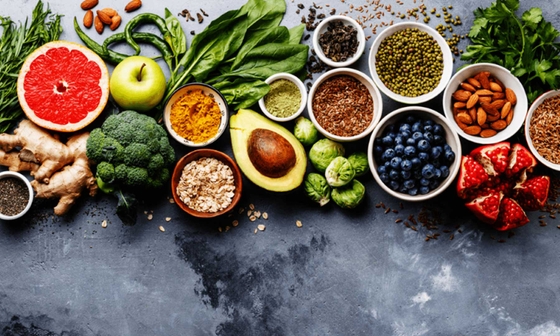
Salt and heart health
Key takeaways
4 min read
- Eating too much salt can raise blood pressure which is a major risk factor for heart disease and stroke.
- Most Australians consume nearly double the recommended daily amount of salt.
- Processed and packaged foods contribute the most salt in our diets.
- The best way to reduce salt intake is to focus on fresh, whole foods and flavour meals with herbs and spices instead of salt.
Why is it important to reduce salt for heart health?
Salt is made up of sodium and chloride. Sodium is essential for your body, helping with nerve signals, muscle movements and fluid balance. However, too much sodium puts extra pressure on your blood vessels, which can increase blood pressure and lead to serious conditions like heart disease, stroke and kidney problems.
High blood pressure is one of the biggest contributors to heart disease. Reducing the amount of salt in your diet is one of the most effective ways to help lower your blood pressure and protect your heart.
Research shows that cutting back on salt by just 3 grams a day (which is about 1000 mg of sodium) could lead to fewer people needing blood pressure medication, and could help reduce deaths from stroke and heart disease.
Where is salt hiding in your food?
Most of the salt we eat doesn't come from table salt. Around 75 to 80% of the sodium we eat comes from processed and packaged foods, where salt is added during manufacturing to preserve shelf life or boost flavour.
You might not always taste it, but some everyday foods can be surprisingly high in salt.

These foods are often called “discretionary foods,” meaning they’re not essential and are usually higher in salt, saturated fat, or added sugars. They tend to take the place of healthier options like vegetables, fruits, and wholegrains in our diets.
Even some foods that seem healthy like some soups, baked beans, or cheese, can be high in sodium. This is why reading food labels can help you make better choices and support your heart health.
How much salt should you be eating?
The Heart Foundation recommends adults eat no more than 5 grams of salt per day. That’s around 2000 mg of sodium, or about one teaspoon of salt. This amount gives your body the sodium it needs while helping to reduce your risk of high blood pressure.
Right now, the average Australian eats about 9 grams of salt per day, which is almost double the recommended amount.
It’s also worth knowing that all types of salt contain similar amounts of sodium. That includes sea salt, Himalayan pink salt, rock salt, and regular table salt. Despite the marketing, none of these options are better for your heart health.
What about low sodium salt substitutes?
Low sodium salt substitutes replace some of the sodium in regular salt with potassium. They can help lower blood pressure and reduce the risk of stroke and heart disease. The World Health Organization supports their use as a way to reduce sodium intake across the population.
However, in Australia, these products are not widely available and can be more expensive than regular salt, which may limit their use. They are also not suitable for everyone, especially people with kidney disease or those on certain medications. If you are thinking about using a salt substitute, it is best to talk to your doctor or health professional.
How to eat less salt
Small changes can make a big difference. Here are our top tips to make heart-healthy choices everyday.
Use herbs and spices instead of salt
Fresh or dried herbs like basil, parsley, coriander, oregano, or rosemary can add flavour without needing salt. Garlic, ginger, lemon juice, vinegar and chilli can also lift the taste of your food.

Avoid adding salt at the table
Taste your food first. You may find that you do not need extra seasoning.
Choose low salt alternatives
Many canned and packaged foods now have lower salt options. These are usually labelled as "no added salt," " reduced salt," or "low salt." Alternatively, read the nutrition information panel and choose products with lower sodium in the “per 100g” column.
- <120 mg = low
- 120–400 mg = moderate
- 400 mg = high
Spot hidden salt that sneaks into sauces
Soy sauce, tomato sauce, gravy and stock powders can be very high in sodium. Try using smaller amounts or finding lower salt alternatives.
Cook at home with fresh ingredients
Most fresh, whole foods are naturally low in sodium. When you base your meals on vegetables, fruits, wholegrains, legumes and lean proteins, you will naturally reduce the amount of salt in your diet.
Cooking at home helps you stay in control of how much salt is added to your meals. You can choose ingredients with lower sodium, add more herbs and spices, and reduce or leave out salt altogether. Unsure where to start? Sign up to our Heart-healthy Dinner Plans.
Train your taste buds
Over time, your taste buds will adjust to a lower salt diet. As you eat less salt, your preference for salty foods decreases and you will start to notice and appreciate the natural flavours in food.
Use our calculator to convert salt into sodium and vice versa
Check out this sodium and salt calculator, which converts the sodium listed on food products into grams of salt or vice versa.
Looking for more information on the science behind our recommendations?
We understand there is a lot of nutrition misinformation, and it’s important to find information from credible and trustworthy places. The Heart Foundation’s Heart Healthy Eating Pattern recommendations, and associated resources, are backed by the latest science and made with the unique needs of Australians in mind.
Curious about the evidence that informs our recommendations? Read more about our evidence reviews and position statements.
More healthy eating tools and resources
- We have plenty of resources to help you follow a heart-healthy eating pattern.
- Build your skills and confidence in the kitchen with our tips and tools for planning, shopping, and cooking healthy meals.
- Explore our full range of recipes for delicious, budget-friendly and easy to prepare heart-healthy meals you can make at home.
- Discover our collection of free recipe e-books, from ‘Family recipes on a budget’ to '5 Ingredient Recipes' plus many more.
- Get four weeks of easy-to-follow dinner recipes, shopping lists, tips and other helpful information to make healthy eating easy with our free Heart-Healthy Dinner Plans.
- Looking for more information? Explore our resources on healthy eating and recent articles.
You might also be interested in...

How much salt should you have per day?
Use our sodium to salt converter to calculate how much salt you're eating. Find out your daily salt intake and tips to cut back for better heart health.

How to follow a heart healthy eating pattern
Follow these easy tips to boost your heart health and embrace a heart-healthy eating pattern.

9 food and heart health myths, busted
Let’s dive into nine common food and health myths and the facts behind them.
Last updated19 May 2025
Last reviewed20 May 2025